
Isolated and modernized Peruvian Indians
IN ORDER to understand the living descendants of the ancient residents of the high Andes it is essential that we know their environment. Their climate is cold at night the year around. While during the winter the snow is deep in the high mountains, there is very little on the plateau, since Peru is near the equator extending from 5 to 16 degrees south latitude. The sunshine is bright and warm even in winter. Consequently they have pasturage for their animals the year around.
The only native domesticated animals of the Andean Plateau are the llama and the alpaca. Both of these belong to the camel species, as does the vicuna. The llama is the Indians' beast of burden in the Andes. Only the males are used. The animals are very docile and respond with gentleness when treated with kindness. One continually marvels at the ease with which the Indian guides his loaded caravan with soft words or motions, never with harshness. The llama has many unique features as a beast of burden. It forages as it moves along and consequently must be driven very slowly. Each animal will carry a burden not exceeding a hundred pounds, and if more is placed on its back it will immediately lie down until the extra burden is removed. The llama has broad doubletoed feet like the camel which make it very sure-footed. It requires no shoeing and exceedingly little care. It can thrive, however, only in the high altitudes. The wool of the llama is coarse and is used for heavy, rough garments. The alpaca is a little smaller than the llama and produces a very heavy wool of fine quality. Accustomed as this animal is to the severe cold and the high altitudes, as well as to the rain and sun, its fleece is both durable and warm. It is used extensively throughout the world for suits for aviators. The native colors vary from white to bluish tints and from light to very dark browns. It accordingly provides very stable colors for weaving directly into ponchos and native apparel. The vicuna is a much smaller animal than either the llama or alpaca. It has one of the most highly prized coats of fur produced anywhere in the world. This animal has never been domesticated; vast herds have lived wild on the high slopes of the Andes mountains. The demand for vicuna fur became so great that a million and a half of these animals were slain in one year to obtain their fur pelts. The result is that the Peruvian Government has now completely forbidden their destruction. The garments of the ruling class of the Incas were made of the vicuna wool.
One of the important objectives of my trip to Peru was to find and study, if possible, some descendants of these Andean stocks. Fortunately, large numbers of the Aymara linguistic stock, the descendants of the Tauhuanocan culture, are still residing in southern Peru and Bolivia where they are said to retain the essentials of their ancient methods of living. They constitute the principal native populations in the vicinity of Lake Titicaca and the high mountain plateaus of southern Peru and northern Bolivia. I have always encountered difficulty in persuading the native peoples to allow themselves to be photographed in their primitive costumes. They are usually willing to be photographed provided one will wait for them to put on some modern garment.
I am reminded of an experience on one of the South Sea Islands where there was need for roads, but no money with which to build them. Laws were passed by the chiefs that anyone approaching a highway in native garb where he might be seen by a foreigner was subject to arrest and to payment of a fine which had to be worked out as labor in building roads. Of course, on that island no one would allow himself to be photographed without some modern clothing. One boy presented himself wearing a single garment, a man's full dress vest, which had evidently reached the island in a missionary barrel.
The hats in the pictures in Fig. 84 are of native design and manufacture. They are made of fur and are like our modern derbies in construction.

It is important to note the roundness of the features of the Aymaras, the wide development of the nostrils for air intake and the breadth of the dental arches. Many of them had been transported several hundreds of miles to a coffee plantation because of their adeptness and skill in sorting imperfect coffee beans from the run. As I watched them I found it difficult to move my eyes fast enough to follow their fingers and pick out from the moving run the undesired or imperfectly formed kernels. This revealed a superb development of coordination. The wisdom of these Aymaras is discussed in Chapter 21.
I was very anxious to study the Incas in different parts of the high Andes, particularly some of the original type in the vicinity of Cuzco, their ancient capital. Throughout the Andean Plateau, the Indians from the higher elevations bring down their wares on market days to exchange with Indians from other localities, as well as to meet and visit with their friends. They are very industrious and one seldom sees a woman, either shepherding the stock or carrying a burden, who is not busily engaged in spinning wool. While their wool is obtained in part from sheep that have been imported, a great deal of it is obtained from the alpacas which, like the llamas, are raised in the high altitudes where the Indians always prefer to live. I was fortunate in making contact with several groups of Indians in high altitudes through the kindness of the prefects. A group of Indians from the high mountains of the Urabamba Valley near Cuzco is shown in Fig. 85. An examination of this group of twenty-five revealed the fact that not one tooth had been attacked by dental caries and that, at all ages, the teeth normally due were present.
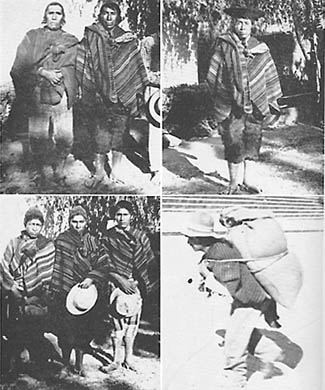
In Fig. 85, lower right, may be seen a typical Indian of the Andes carrying a heavy load. The Indians of this region are able to carry all day two hundred to three hundred pounds, and to do this day after day. At several of the ports, these mountain Indians have been brought down to the coast to load and unload coffee and freight from the ships. Their strength is phenomenal.
In approaching the study of the descendants of the Inca culture, it is important to keep in mind a little of their history and persecution under the Spanish rule. To this day they are bitter against the white man for the treachery that has been meted out to them on many occasions. Their leader was seized under treachery. The agreement to free him, if the designated rooms were filled with gold as high as a man could reach, was broken and their chief killed after the gold was obtained. It is recorded that some six million of them died in the mines under forced labor and poor foods under the lash of their Spanish oppressors. In many places they still keep themselves aloof by staying in the high mountains of the Andes with their flocks of llamas and alpacas. They come down only for trading. As in the past, they still weave their own garments. Indeed, they provide practically all of their necessities from the local environment. Their capacity for enduring cold is wonderful. They can sleep comfortably through the freezing nights with their ponchos wrapped about their heads and with their legs and feet bare. They wear two types of head cover, one inside the other. Several individuals are seen in Fig. 85. Many of them have faces that show strong character and personality.
The women of this district wear felt hats which can be turned up or down according to the weather. Fine examples of weaving were worn by the women.
In Fig. 86 will be seen two young men who had just come down from the high mountains to a government school. The one in the lower photograph is still wearing his native costume. The one in the upper has discarded his native costume for white man's trousers. Note the fine development of his chest, the splendid facial development and fine teeth and dental arches. It is important to keep in mind that these people are living in a rarified atmosphere and that, because of the high altitude, they need greater lung capacity and stronger hearts than do the people living at sea level. The ratio of oxygen content is reduced about half at 10,000 feet.
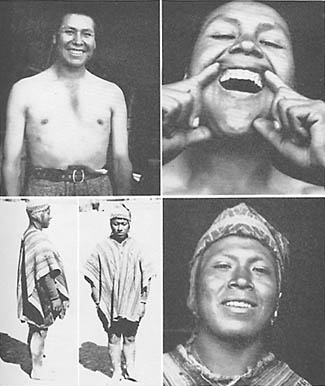
The broad dental arches of these Indians are shown in Fig. 87. Note the extensive wear of the teeth at the upper left. Much of the food is eaten cold and dry as parched corn and beans. Such rough foods as these wear the teeth down.
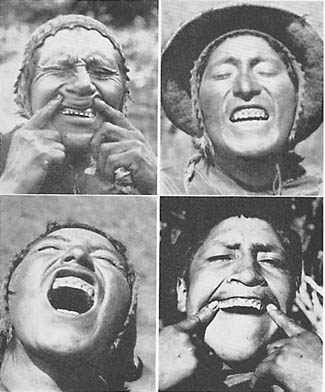
Market days which usually occur on Sunday present an interesting scene. The Indians travel long distances with their wares for exchange. They have no currency and exchanges are made by bargaining.
Where these Indians have become modernized, the new generation shows typical changes in facial and dental arch form as reported for the other groups. There is also a marked character reaction which will be discussed in detail in Chapter 19. In Fig. 88 are shown four typical modification patterns due to the influence of modernization after the foods of the white man have displaced the native dietary.

An important item in the life of the Andean Indians is the satisfaction they get from chewing cocoa leaves from which is made our modern cocaine. In order to extract the alkaloid they chew with these leaves the ash produced by the burning of a particular plant. This drug is chewed as tobacco, one large quid will last for several hours. Practically every Indian carries in a little pouch a quantity of these leaves in dried form. The effect of this drug is to increase their capacity for endurance. It makes them unconscious of hunger and fatigue. Through our interpreter we frequently asked them regarding the comfort or nourishment they obtained from the leaves and were told that they often preferred these leaves to food when they were on a journey and carrying heavy loads. I was informed that they can increase the quantity of the drug used to a point at which they are quite unconcious of pain and able to endure injuries without suffering, and operations without discomfort. Since packets of these leaves were found in the burials near the coast, it is clear that the drugs were used throughout Peru in early times. It is also of interest that several of the skulls taken from the cave in the high Andes, were found with trephine operations in the skulls similar to those found in the burials along the coast.
The physical perfection and development of the present and past Andean population has been accomplished in spite of the difficulty of building and maintaining good bodily structure at the high altitude where dairy products have not been and are not at present a large part of the nutritional program. In this regard the ancient and contemporary peoples of the Andes differ radically from the present and past groups of people who live in the high valleys of Switzerland and Tibet where milk is plentiful. The cow, sheep, horse and pig have been imported into the high Andean countries during the last four hundred years since the Spanish Conquests, but they have not acclimatized easily. The earlier cultures were of course, dependent upon the llama, alpaca, wild deer, birds and guinea pig for animal foods. While there have been vast burial mounds built and preserved in the coastal regions where the absence of rain and the dry sand have added materially to their preservation, the rainy seasons have established very different conditions for skeletal preservation in the high altitudes. Nevertheless, a large number of skeletons in good state of preservation have been recovered.
The high Andean plateau extends throughout the length of Peru between the mountain chains. The present Indian stock was studied in four different places in the high plateau country, the farthest north being Huaras. In this area we were materially assisted by the governor of the province who very kindly sent messengers and brought down Indian families from high altitudes to the police headquarters at Huaras. This place is at an elevation of about 11,000 feet. We had an opportunity to study also many who had come from the higher altitudes to the markets to sell their wares. Huaras lies in a fertile valley that has been in contact with modern civilization for many decades. This vicinity, therefore, provided a wide range in classes of people, from Indians who are isolated to those who are living in highly modernized groups. In addition to the opportunity for studying the older people there were opportunities for studying adolescents in the two high schools, one for girls and one for boys. Some were pure-bloods who had been highly isolated in their formative and childhood periods. The mixed-bloods had been considerably modernized. There were some whites. I was told by the prefect and others who were well informed that there was quite a distinct difference between the Indians who were living in the high northern Cordillera, the western Andean range called the Black Mountains, and those living in the eastern range or White Mountains. The latter were physically much better built and were least modernized. Typical low immunity to caries and changes in facial and dental arch form were found in these modernized groups.
Another important area in which the native Indians were studied was Chiclayo. This district is unique in large part because of the influence of the modern civilization at Lima with which it is connected by the railroad. The native market here is very large and occupies about a mile of the main street of the town, through which no traffic except pedestrian traffic can pass while the market is in session. The town has been under the influence of the Spanish since the time of the Conquest. It has many colonial buildings and a large cathedral. It has not, however, accommodations for the influx of tourists who come out of curiosity for the purchase of Indian wares. With the aid of the prefect, even though no public accommodations were available, we were made very comfortable in the soldiers' barracks. As the Indians came down from the mountains to display and sell their wares, they were brought to us at the barracks. Since this district has been in quite intimate contact with the nutrition of the modernized capital, we found here many individuals showing typical degeneration of the teeth and dental arches.
The adaptation of racial characteristics to the environment in which they have developed is very strikingly illustrated in the Indian cultures of the Amazon jungle district. We were very fortunate in being able to make studies of some groups living at present as did their ancestors through countless centuries in the Amazon basin. We were greatly pleased and impressed with the splendid physiques and fine personalities of many of the individuals of the groups.
The abundance of rain, the fertility of the soil and the warm climate make plant growth most luxuriant on the eastern slopes of the Andes. It is of interest that in passing from the capital, Lima, across the desert stretch between the ocean and the mountains and then up the wall of the Andes to an altitude of sixteen thousand feet and then down to the plateau at about twelve thousand feet and up again over the eastern range and down into the Amazon basin, one has passed through the tropics, temperate zone and sub-arctic zones with varieties of plant life corresponding to each. A distance of a few hundred yards will often divide the limits of particular birds and flowers. When one reaches the foothills of the Andes on the eastern side, he is in a region of rushing streams teeming with fish, a region of tropical fruits and vegetables. It is in this setting that some of the finest Indians we have seen were enjoying life in its fullness. The type of shelter is very simple, indeed, consisting as it does of a framework covered with banana and palm leaves. We were privileged to meet by special arrangement about thirty of this tribe who had been brought from some distance by the officials of the Perene Colony, owned and operated by the Peruvian Corporation. In Fig. 89 will be seen the chief and one of the noble women of his retinue. They understood that they would have their pictures taken and came dressed in royal regalia. Typical countenances are seen in Figs. 90 and 91. These people have very kind faces with broad dental arches, and a high sense of humor. They decorated their faces especially for their photograph. In the entire group associated with this chief I did not find a single tooth that had been attacked by dental caries. The fine dental arches are illustrated in Figs. 90 and 91. Many of these young men had really noble countenances, such as would rate them as leaders in modern science and culture.
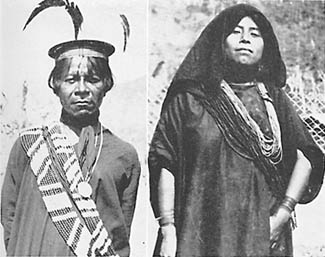
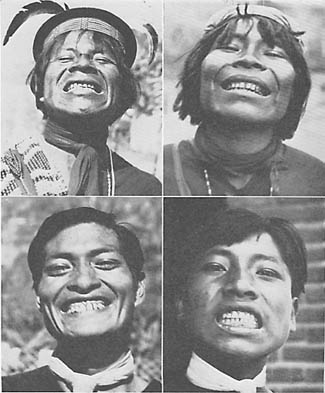
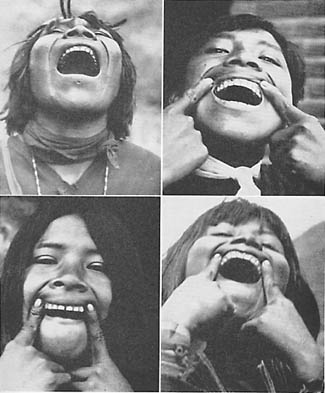
In another tribe, however, of the same racial stock, efforts to modernize had been in operation for some time by a mission. The food of this latter group had been distinctly affected by their contact with the modern group. By reducing the animal foods, the change in physical efficiency, and appearance of tooth decay, is most marked. In Fig. 92 above will be seen typical cases of rampant tooth decay with extensive loss of the teeth. In Fig. 92 below are shown two of the first generation following the adoption of the modernized type of diet in this group. Note the narrowing of the faces with crowding of the teeth. Note the deformed dental arches.
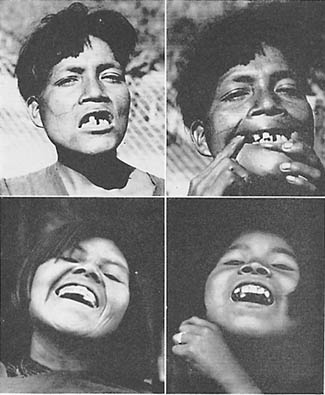
The native foods of these Amazon Jungle Indians included the liberal use of fish which are very abundant in both the Amazon and its branches, particularly in the foothill streams; animal life from the forest and thickets; bird life, including many water fowl and their eggs; plants and fruits. They use very large quantities of yucca which is a starchy root quite similar to our potato in chemical content. This is not the yucca of North America.
The Peruvian Indians, in the highlands and in the eastern watershed of the Andes, and also in the Amazon Basin, have built superb bodies with high immunity to dental caries and with splendidly developed facial and dental arch forms while living on the native foods in accordance with their accumulated wisdom. Whenever they have adopted the foods of modern civilization and have displaced their own nutrition, dental caries has been found to be wide-spread; and in the succeeding generations following the adoption of modern foods, a change in facial and dental arch forms has developed. The modernized foods which displaced their native foods were the typical white man's dietary of refined-flour products, sugar, sweetened foods, canned goods, and polished rice.
Next
Table of Contents
Back to the Small Farms Library